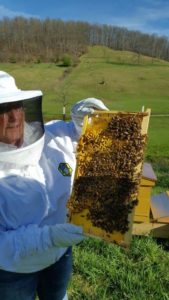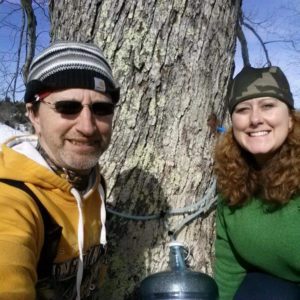
Terri Jo currently has four hives producing honey.
By Roger Poling, West Virginia Farm Service Agency Lewis-Upshur-Gilmer County Executive Director
Terri Jo Bennett operates a small, diverse farm, where she raises and sells several varieties of berries, maple syrup, eggs and honey.
In June of 2003, Bennett, along with her husband, Dale, and three children, moved from downtown Buckhannon to an 85 acre family farm in Tallmansville, an unincorporated community in Upshur County West Virginia. A year later, she purchased a brood of black Sex Link chicks (Also known as Rock Red). That fall, after they began laying, she started selling eggs to local stores, restaurants and neighbors to help offset the cost of feed.
Noticing the farm was also home to several maple trees, Bennett decided in 2014 that she would try making maple syrup. That initial system has grown to tapping 91 trees and producing over 13 gallons of syrup in 2017. During the summer of 2015, with the help of her neighbor, she caught two honey bee swarms and now has four hives producing honey. Bennett’s interest in honey bees led her to join the Upshur County Beekeepers Association.
“At one of our local Beekeeper’s meetings, I was told that I should contact the local FSA office to report my honey bees in case of a disaster,” she said.

Terri Jo began making maple syrup in 2014. Her operations has grown to tapping 91 trees, producing approximately 13 ½ gallons of syrup in 2017.
She contacted the USDA Service Center in Weston, West Virginia, and learned about the Noninsured Crop Disaster Assistance Program (NAP). NAP provides financial assistance to producers of noninsurable crops when low yields, loss of inventory or prevented planting occur due to natural disasters.
Bennett enrolled in the program, covering her honey and maple sap.
“NAP is a way for me to secure my time and efforts at a very inexpensive cost,” she said. “Even on the small-scale farming I do, the assistance offered through the program for damage and loss of production yields that are out of my control helps to offset the rising cost of farming.”
This year, the Northeast experienced a mild winter and an unseasonably warm spring. The weather conditions led to a low yield for Bennett’s maple sap production.
To be eligible for payment, a natural disaster must occur during the coverage period, before or during harvest, and must directly affect the enrolled crop. Eligible causes of loss include damaging weather, adverse natural occurrences or other related conditions.
“Being a participant in NAP, I will be able to recover some of the income loss from my low production,” said Bennett.
For more information about NAP, contact your local FSA office or visit www.fsa.usda.gov. To find your local FSA office, visit http://offices.usda.gov.






One Response to USDA Disaster Program Helps West Virginia Farmer Bounce Back After Production Loss